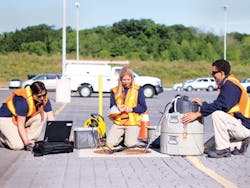Partnering to Fund Innovation
On July 8, 2013, the Toronto area experienced its most intense storm in recent years. Parts of the city were pounded by 4.7 in. of rain, most of it falling within a two-hour span. Basements flooded and infrastructure was damaged. The storm was the most expensive natural disaster in the history of the province of Ontario, with a total of $900 million in insurance claims. It drove home the need to upgrade aging infrastructure and find innovative ways to manage storm water.
Credit Valley Conservation is an environmental agency in the Toronto area that is exploring innovative green technologies to manage storm water as close to its source as possible. These approaches, called low impact development (LID), can be incorporated into the existing urban area, requiring little to no additional land to build capacity.
There is a growing appetite for LID in Ontario’s public and private sectors, especially in light of climate change. Experience has shown the benefit of funding partnerships—organizations at all levels working together to advance knowledge and application of storm water management techniques. A parking lot retrofit at IMAX Corp.’s head office in Mississauga, Ontario, is an example of innovative storm water management in action, both in its application and how it was funded.
The Opportunity
IMAX was growing and needed to expand its parking lot to accommodate new staff. It also identified drainage issues that caused its asphalt lot to crack. There was surface ponding and freeze-over in winter, which created the risk of slip-and-fall injuries to staff and visitors. There also was infrastructure damage caused by localized flooding.
Many businesses see the need for onsite storm water management features to protect their investments, in addition to relying on the municipal storm water infrastructure. This can be compared to hiring a private security firm while also relying on municipal police. It can make sense financially, and the cumulative effect of LID sites can lessen the burden on municipal storm water management systems.
The retrofit was a public-private partnership that leveraged funds and expertise from IMAX, the government of Ontario, Credit Valley Conservation, other funders and a number of local suppliers/experts that provided in-kind contributions.
The IMAX parking lot now is a fully monitored LID site. It contains more than 39,826.5 sq ft of permeable paver surface and three bioretention cells, each with two water filtration technologies that manage parking lot drainage. Runoff is collected, absorbed and filtered before entering a nearby creek.
The permeable pavers and other LID features have twice the lifespan of conventional asphalt (40 years versus 20 years). They have reduced IMAX’s winter maintenance costs by $345 per month, mainly due to less de-icing salt needed for permeable pavers. The retrofit provides green amenities for IMAX staff to enjoy and reduces localized flooding. Projects like this create local green jobs and build capacity for made-in-Ontario technologies.
Leveraging Partnerships
IMAX covered the construction costs. Grant funding from the government of Ontario is being used for ongoing performance monitoring. This will help inform new standards to protect the health of the Great Lakes and build resiliency in light of climate change.
Credit Valley Conservation and IMAX also partnered with a number of local suppliers:
- Unilock provided permeable pavers at a discounted cost.
- Imbrium Systems provided proprietary filtration materials at a discounted cost and contributed to the cost of ongoing performance monitoring.
- Fernridge Landscaping contributed plants for the bioretention cells.
- Aquafor Beech contributed monitoring equipment.
- The Ontario Centre of Excellence and the Metcalf Foundation both contributed to the cost of ongoing performance monitoring.
- The University of Guelph is providing additional monitoring support with data analysis and testing.
- Minotaur is providing site maintenance at a discounted rate.
- MAXXAM is providing water quality sampling services at a discounted rate.
The importance of understanding each partner’s goals and communicating the benefits in ways that make sense to them was paramount to this partnership. Corporate landowners are concerned with a number of factors. There is the risk of localized flooding in terms of infrastructure damage and personal injury, ongoing maintenance costs, aesthetics of their grounds, their standing in the community and ecological footprint.
In this case, the government of Ontario was interested in funding a series of pilot projects to test new storm water management approaches that supplement existing infrastructure. The government of Ontario and the suppliers were mutually interested in stimulating the local green economy and creating green jobs.
A market analysis was conducted that showed increased demand for LID projects. For example, Imbrium Systems expects to bid on approximately 1,000 LID projects over the next five years. The suppliers also were interested in promoting their services through a high-profile project.
The parking lot retrofit is one of the first commercial parking lot retrofits in Ontario to incorporate a variety of LID technologies. Credit Valley Conservation and IMAX were recognized with the Minister’s Award for Environmental Excellence, presented by Ontario’s Minister of the Environment and Climate Change. The parking lot is used as a demonstration site, showcasing LID technologies through presentations, events and site tours.
Download: Here


